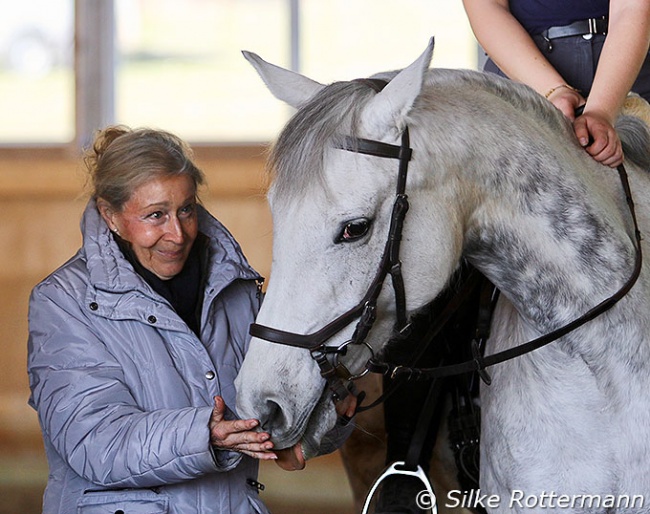
-- Text and Photos © Silke Rottermann for Eurodressage
It is a good question why it took me a so long time to visit a clinic of Christine Stückelberger, THE dressage rider of the 1970s? I have known Christine personally for almost 25 years and it is thanks to the generosity and patience of her lifelong trainer Georg Wahl (1920-2013) that nowadays I am able to tell apart a well trained horse from a poorly one.
Christine’s teaching is, in a way, resembling that of her late trainer: She gets the riders out of their comfort zone in favour of their horses.
I finally took the opportunity to follow Christine’s teachings again on 27 March 2022. On that glorious sunny Sunday the Baroque Riding Center in Heimsheim, near Stuttgart, hosted the 2nd day of Christine’s first clinic there of 2022.
First seat, then legs, only then the reins
Those who first meet Christine Stückelberger would never expect this petite woman sitting in the corner of the beautiful indoor arena to have such resilient strength almost 75 years of age. All her life Christine’s overwhelming love for horses has been the fuel that drives her. Her ambition is to make her students better riders, so they can do their horses as much justice as possible.
The strictness and consequence with which she challenged the riders in the clinic might have been a bit surprising for those who never met her before, but it is also exactly what her long-time students appreciate so much. And who thinks that training with an Olympic and World champion means finally riding a piaffe when the horse is still heavy on the hand or not sensitive to the leg, were proven deadly wrong.

, with the rider being 16 and the horse 7.
"Back-to-front" riding is the main goal and this is only possible if the rider learns to ride from the seat, to initiate transitions without the reins, or to induce collection with the core. Not surprisingly many riders struggled with that classical concept on which many trainers agree but so few insist on - at least in the persistent way Stückelberger does.
"Do not push! Let your horse do it itself"
First to go in the clinic on that Sunday morning was a horse girl's typical dream: a shiny black horse with long legs, and super refined head.
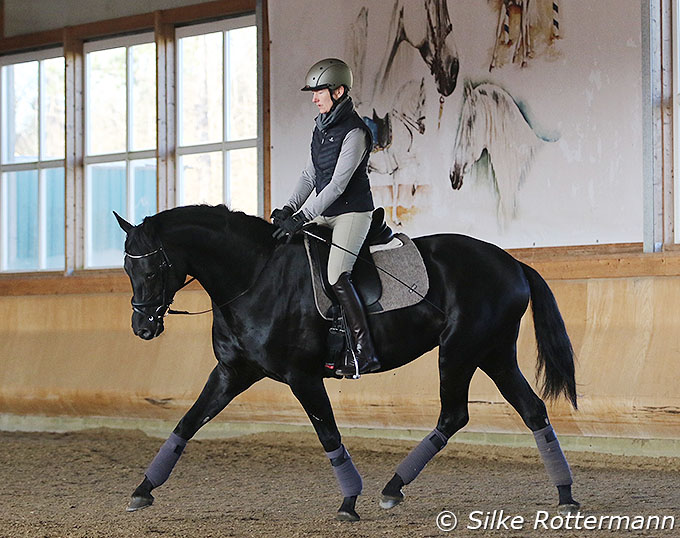
end of the lesson
For the onlooker she sat and rode very nicely and refined, but Stückelberger sensed that the aids were still not on the level of refinement which the black mare was most comfortable with.
"You have to breathe and feel with your calf, your leg needs to be relaxed," she told the rider. Soon the mare trotted with a relaxation and a lovely rhythm that was a universe away from the tense disconnected trots with stiff backs we have to suffer so often on the international level. "The relaxed and content horse is our goal," Christine stressed and true to her word she got a little cross when tension creeped in the moment the mare should execute a transition into canter. "No counter pressure if your mare resists, on the contrary: Open your legs and put your hand forward," Christine advised.
What sounded logical is less easy to immediately put into practice like a reflex. The 8-time Olympian was aware of it. The horse’s natural movements without tension is what she aims for and she showed the riders how to achieve it via riding with aids used at a minimum, but cleverly applied. "If horse and rider are in balance, the hind-legs are in the right place," said Stückelberger.
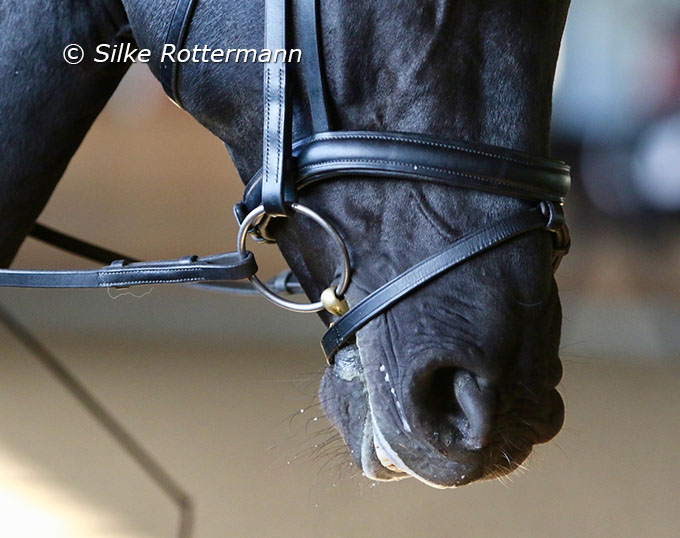
for achieving a contact which allows refined riding
The stunning black beauty got back into the harmony she showed at the beginning, snorting contently and with a tail carried in a relaxed way. She also did not get faster when Wais lengthened the reins for her to stretch. Instead she followed the hand with a lot of faith while keeping her tempo and beautiful rhythm.
It was a lesson which only focused on the horse feeling well and the rider becoming aware that despite her already very confirmed seat and position there is always room left for further improvement.
"I totally appreciate Mrs. Stückelberger’s merciless strictness and honesty, her relentless corrections which pull myself completely out of the comfort zone," said the rider. "She is always friendly and the working atmosphere is very nice. Everything happens in favour of the horses and should be even more refined. This matches my sensitive mare very well as she is somebody who would never accept a 'you must'," Wais commented on her lesson in which there was no piaffe and passage, no pirouettes.
Christine highlighted, "the movement went through the whole body of the horse and this is the true beauty of classical dressage."
"The horse can also do something by and carry herself"
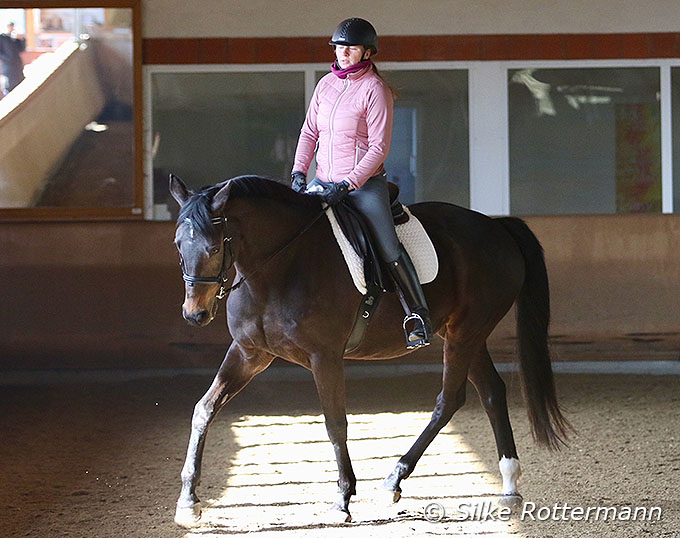
Minimize the aids and allow the horse to work as much on its own as possible" is the credo which ran like a red thread through all of Christine's lessons. It created very harmonious pictures which we unfortunagely see too rarely in dressage sport.
"If you want to ride a half pass you have to initiate it from your seat. The inside hip indicates the lateral movement, but the horse also needs to have a certain will to go forward, it needs to react promptly to the leg aids or that kind of riding won’t work," she said. Only when Tosca was truly with her rider and as refined in the contact as Stückelberger wanted her to be, was Willmann allowed to attempt the trot half-passes. Only then "the horse can do something on her own and will carry herself."
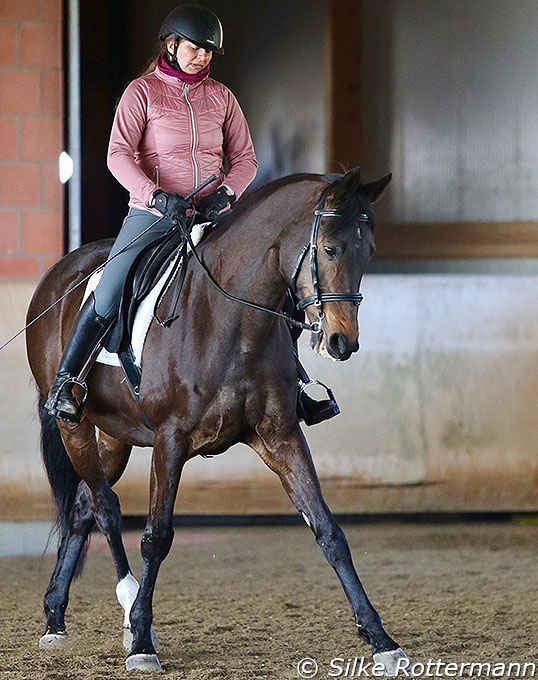
In moments like these Christine Stückelberger can be enthusiastic and delighted like a little girl getting her desired Christmas present. Strictness and persistence then resolve in prompt and honest praise. A short "You did that really well" or "Did you feel that? Your horse can do it, but you have to allow her to work like that" are the clear reward for the riders, who lose sleep over the exciting opportunity of riding in front of the Olympic champion of 1976.
Praise is her key word when working with horses. This can also mean that if a horse has worked extremely well, Christine will sent him back to the stables even if there are 5 minutes left to a lesson. With horses you cannot really set the clock, so sometimes she was also working a bit longer with some horses than the foreseen 30 minutes unit.
"Impulsion resides in collection and not in chasing the horse forward"
The most interesting part of clinics like these lies in the often wide variety of horses and riders you see. It can range from professionals to pleasure riders, with the ambitious amateur in between and their likewise different four legged partners. On such occasion one can see whether a teaching method of a trainer - no matter how famous - is working and can be generally applied or not.
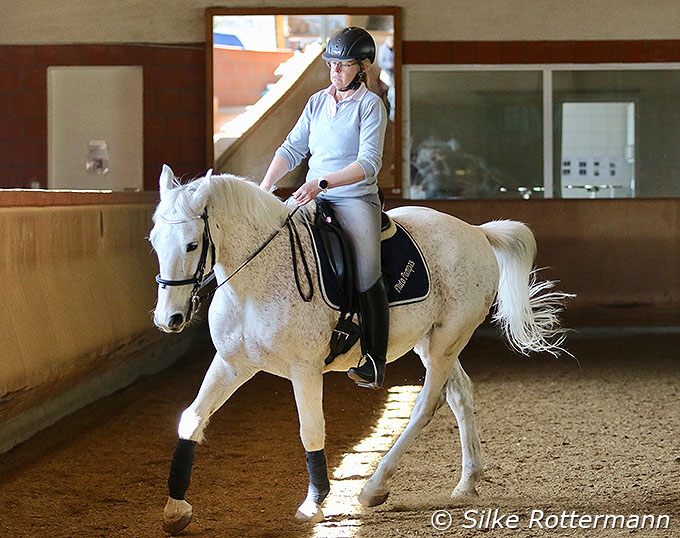
Pompas grew beyond themselves, the horse developing
unexpected impulsion within just one lesson.
One of these clever riders was Elke Thumm who brought her 12-year-old Lipizzan gelding Pluto Pompas for their first lessons with Stückelberger.
The small compact grey used to be a driving horse until a few years ago. He is described as "a horse who loves to work." Stückelberger’s lifelong trainer Georg Wahl was chief rider at the Spanish Riding School in Vienna and, therefore, she is well acquainted with this breed and their peculiarities.
"I came to the clinic because I wanted to improve the throughness of my horse. Mrs. Stückelberger has a very straight way of teaching to which I needed to get used to on the first day, but today I really tried hard to put her advice immediately into practice," Thumm said.
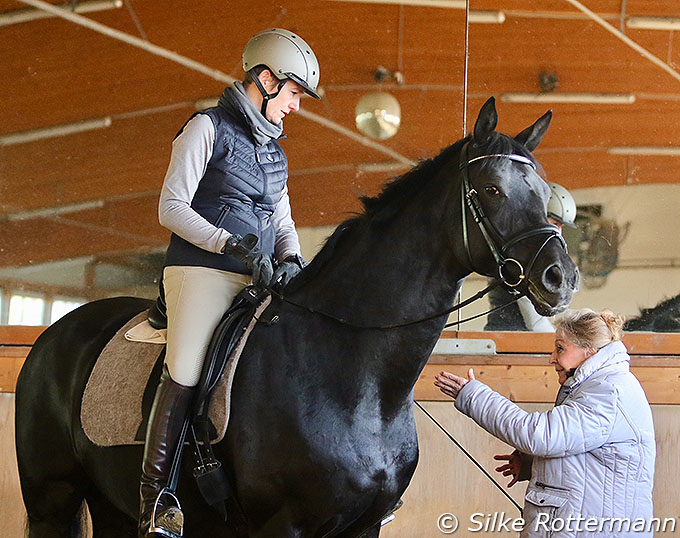
It was a true pleasure to observe how this little horse’s expression and impulsion increased. "You are a natural," Stückelberger praised and then added something which I wisheshe would shout out loudly to those confusing speed for impulsion: "Because impulsion resides in collection and not in chasing the horse forward."
However, that new way of going created new challenges for the rider in sitting trot. "Avoid to compensate this new degree of impulsion by clamping with your knees and legs. Instead open your knees and stretch the leg from the hip down to the heels," was the advice. "The tilting of your pelvis will then act as a kind of shock absorber and allows you to sit.“
Good Equitation is Simply Beautiful and Likewise Challenging
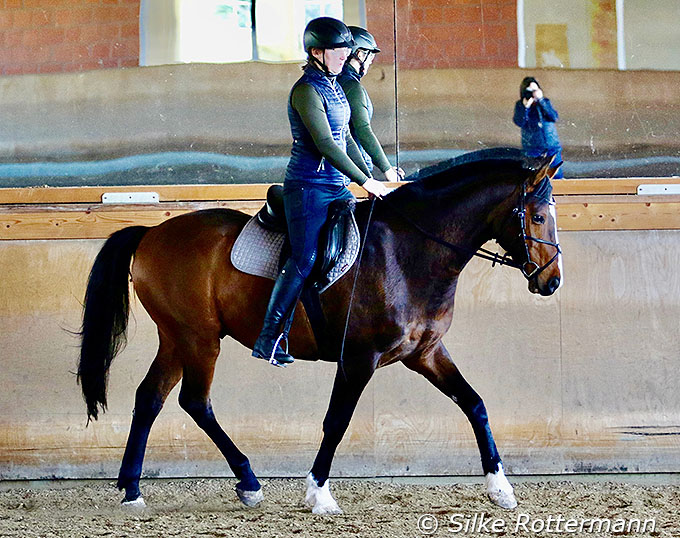
of their horses, here a sympathetic Oldenburger gelding.
Even though the person who gave it her all throughout the day was certainly no stranger to me, I remembered how beautiful good equitation looks like, but also how challenging it is to achieve by the riders.
The peculiarity of Switzerland’s most successful dressage rider of all times is that she challenges the riders to make everything as easy and stress-free for their horses as possible. She works on the riders in that way and by doing so the horses improve as well. There was not one minute pressure or stress for the horses because as soon as the slightest tension creeped in, Stückelberger came to the fore, had the expertise and eye to detect the cause, and helped the riders to eliminate it without bothering their horses.
This approach is certainly one of the most demanding and difficult ways to teach proper riding, but definitely also one of the most profound and horse friendly ones on the planet!
Nuggets of Wisdom from Christine Stückelberger
"Your hand has to act in last place. Your legs initiate the bending, your erected core collection.“
"We are riding too much with our brains and too little with our feeling. Riding by intuition gets lost.“
"You have to explore what is the feel-good frame of your horse, instead of pressing it into the frame you want it to go in.“
"If you ride a horse with a long back downwards, you bring it on the forehand. Then you will have a hard time getting it up again.“
"You should not only ride, but you also need to read a book about equitation now and then.“
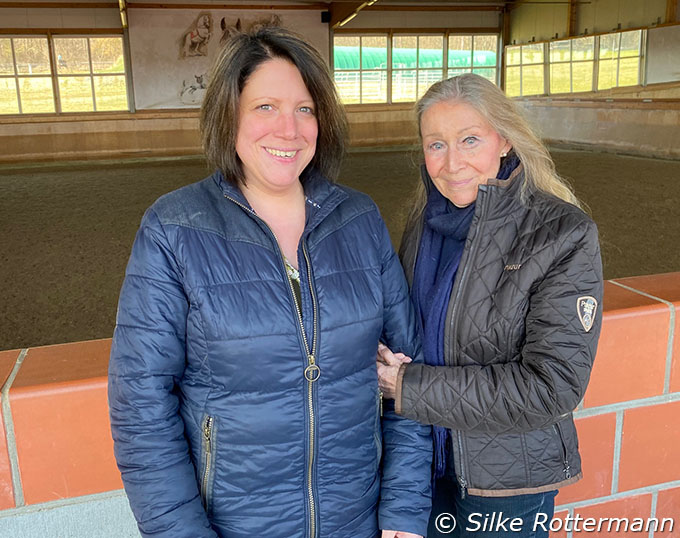
"To give with the hand is the key to success."
"Your wrist needs to be as agile as if you want to play an instrument.“
"If you want to ride a transition to walk or to halt you just have to close your knees.“
"Do not pull at, but ride the reins.“
"Pulling always causes a disturbance in the horse’s way of going.“
"No pressure, no force and no stress“.
-- Text and Photos © Silke Rottermann for Eurodressage
Related Links
Christine Stückelberger: From Equestrian Super Star to Ambassador of Classical Dressage
Granat, From Ugly Duck to Beautiful Swan
Georg Wahl Again Clinicing at De Steppe
Georg Wahl Passed Away
George Wahl's end of the year 1999 Clinic